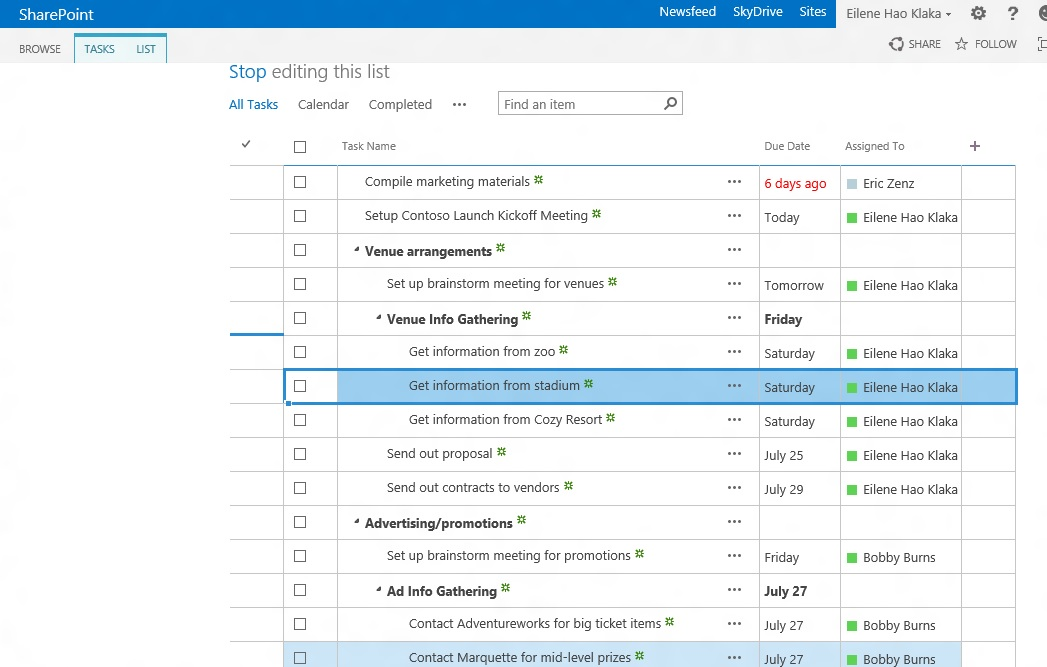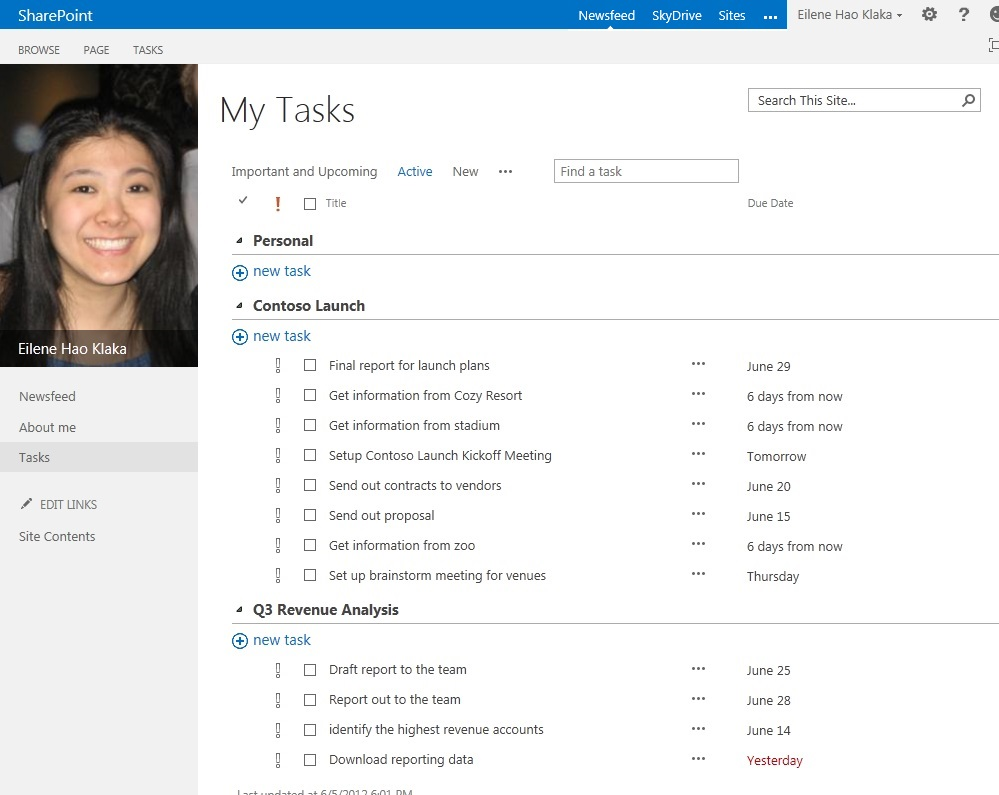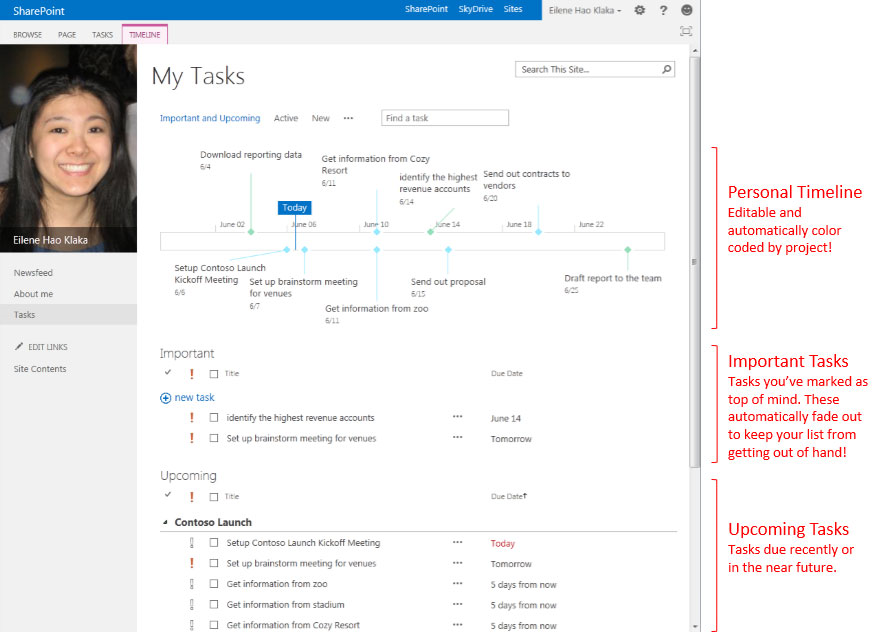Eilene Hao Klaka is a Program Manager on the Work Management Apps team.
Almost any project we work on is collaborative these days. A restaurateur might be working with his staff and publicists to develop and advertise a new menu. A wedding planner might be working with florists and venue coordinators to make someone’s dream wedding come true. You need a way to coordinate to-dos, easily communicate status, and stay in sync with your team without leaving your favorite tools.
In the next version of SharePoint, we’ve created an intuitive new experience for the team as whole to get organized as well as for individuals to stay on top of their work across projects. The two core pieces of this are new task management features for team sites, and My Tasks in your Newsfeed Hub. Let’s take a tour.
Working as a team on a project
In the next version of SharePoint, you can add task management capabilities to enhance any team site so you can get organized, plan and track tasks, and communicate deadlines, all in the same place you store documents and notes. Just click on the “Working on a deadline?” tile on the main page of your new site.

This will give you a few tools to help you do work:
- A tasks list for capturing actions, to-dos, and deadlines
- A calendar to track important dates and meetings, and
- A project summary to keep the team in the loop
Coordinating work and deadlines with the Task List
The new Tasks list is the place for quickly creating and editing tasks for your team. The starting view of the task list is optimized for allowing you to capture the type of info that you might jot down on a legal pad during a phone call: task, due date, and who it’s assigned to. If you click on “edit this list”, you get a grid where you can edit inline like you would in Excel. To address the need to adjust projects as things change or new developments come up, this mode also gives you a lot more flexibility for organizing tasks, including the ability to drag and drop tasks to reorder them and indent tasks to create hierarchy. Forgot to add task that needs to be done between these other two? Just click Insert and add it directly in the middle.

At the top of the page, you’ll find an interactive timeline to give you a visual representation of the most important tasks and milestones. This gives everyone involved with the project a good picture of how their work fits into the context of other tasks. Any task with dates can be added to the timeline with the click of a button using the ribbon or the task callout.

With the task list, it’s easy to get organized around work your team needs to complete and see how you’re doing.
Communicating project status at a glance
The Tasks list is great for the person driving the project but everyone else that visits the site (team members, stakeholders) need an at-a-glance view of the project status. For this, we have the Project Summary on the home page of the site which makes it easy to communicate how the project is going, calls out the next upcoming milestone, and shows a couple of display modes. The first is the timeline (from the Tasks list), which gives casual stakeholders a high level overview of where things are heading. The second is a list of upcoming task deadlines and calendar events, which gives folks who need specific details a good picture of next steps. So anyone who goes to the site will have a good high level picture of how things are going and what people should be working on. At Microsoft, we love using our own tools – we call it dogfooding (or eating our own dogfood). We have a lot of new sites cropping up within Office with the Project Summary on the home page. The feedback has been great. People tell us that having this Project Summary on their site makes them look and feel organized and keeps the team in sync.

Growing with your needs
The Tasks list is a great place to get organized around the team’s work, but sometimes the scope of a project will grow into something larger that needs a greater level of control, structure, and reporting. In these cases, you can open a task list in Microsoft Project 2013. Click the “Open in Project” button in the ribbon to get great reporting features and an even higher level of organization to track your project schedule and deadlines, and saving in Project will synchronize changes directly back into the list for everyone to share.
All My Work in One Place
On average, people work on five to seven projects at a time. For example, the wedding planner may have several clients that she is planning weddings for, with a task management site in SharePoint for each. In this case, she’ll have tasks assigned to her from several different places, in addition to tracking personal tasks outside of those projects.
Rather than drilling into each site individually to see her assignments, she can now use a new feature called My Tasks, under the Newsfeed Hub, to see at a glance all the things she needs to do across projects together in one place.
My Tasks can aggregate all tasks assigned to you in SharePoint, Outlook, and Project into one experience and allows you to organize and manage both personal and assigned tasks alike.
The goal is not just to show you tasks but to be a one stop shop to take action on them too J. Here are some things it can help you do.
Organizing and taking action on tasks
To get to My Tasks, go your Newsfeed Hub and click on “Tasks” in the quick launch. When you first go there, we’ll bring in all your tasks and show them to you grouped by project so that you have context of where they came from.

Once you see your tasks, you’re bound to think of other important things you need to do. My Tasks makes it easy to quickly capture tasks with inline add controls.
To prioritize tasks, you can drag and drop them up and down to reorder them. You can also highlight the tasks that you want to focus on most by marking them as important. Doing this will make them show up in the “Important and Upcoming” view, which we’ll talk about in the next section.
To complete a task, just check the checkbox like you would in a task list and feel the satisfaction of watching it cross itself off and disappear. (You’ll still find these in the Completed view.) You can also edit the task inline or open the task form directly; all changes will be written back to the project site so that the team is immediately aware of your status and updates.
To help you do your tasks, you can also get more context information, including a link to the project site where related collateral lives by opening the callout.

Using “Important and Upcoming” to decide what to work on next
My Tasks provides a special view called “Important and Upcoming” to help you pick what’s next from everything that’s asked of you. It gives you a personal timeline to visualize of all your tasks due in the next few weeks, all tasks that you’ve marked as “important,” and a list of upcoming tasks that are due in the near future. This is a self-cleaning view, meaning that it continually changes content to prevent your task lists from becoming overwhelming. As important tasks linger, they gradually lose prominence in this view so that old tasks that you haven’t gotten around to but aren’t really important anymore don’t clutter the list.

Take tasks with you everywhere
Last but not least, you can synchronize tasks with Outlook. Not only will you see these tasks in Outlook or Outlook Web App, but also in your favorite Outlook tasks app for your phone, such as the Calendar hub on the Windows Phone or the Reminders app on iOS. Just go to the ribbon in My Tasks and click “Sync to Outlook” to turn it on and we’ll sync tasks on a regular basis.
This is just a glimpse of how the next version of SharePoint can help you get organized and stay in sync with your team without leaving your favorite tools. Give it a try and let us know if this makes you more productive and your projects great!








